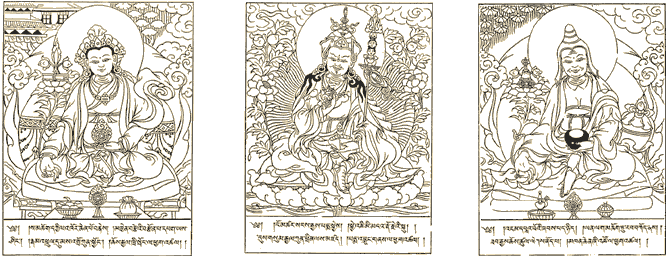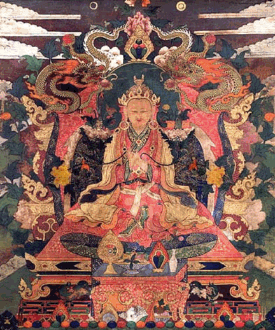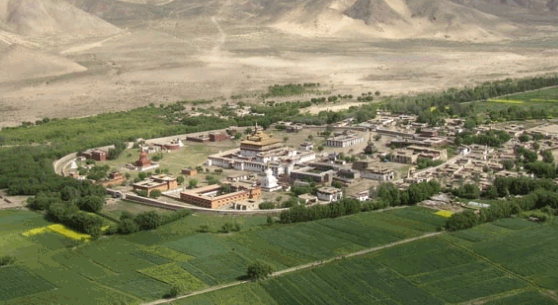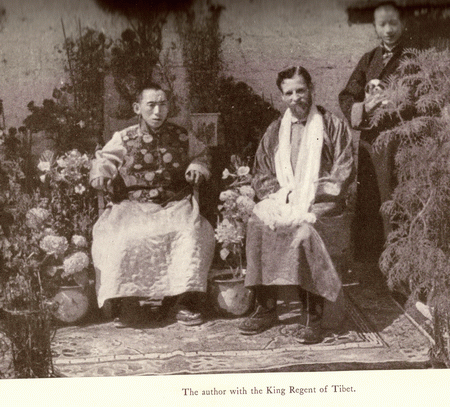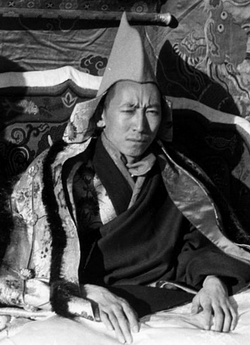Penthouse of the Gods – Theos Bernard – Chapter IX
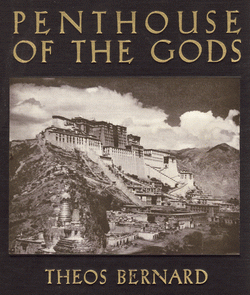 Taken from Chapter IX – ‘I Escape
With My Life’
pp. 230-233
“The Rise and Spread of Buddhism” –
Theos Bernard
Taken from Chapter IX – ‘I Escape
With My Life’
pp. 230-233
“The Rise and Spread of Buddhism” –
Theos Bernard
I spent the rest of the day in making a review of the rise and
spread of Buddhism from the time it entered China in 61 A.D.
and Japan in the sixth century, until it came to Tibet in
the seventh, and flowered there in its own fashion. This
event occurred in the reign of King Srong-tsan-Gampo who, as
I have already told, had been converted to Buddhism by his
Nepalese and Chinese wives, both ardent adherents of the
faith.
He was given the Chinese princess,
Wench’eng, by the Emperor of China, T’ait-sung of the Tang
dynasty, in order to induce him to forego his military
pursuits on the border. The Nepalese princess, Brikuti,
daughter of King Amsuvarman, was first taken in marriage
when he was only sixteen; so the Tibetan annals report. When
the Tibetan King asked for this princess, he is reputed to
have said: The 5th Reting (Regent) Rinpoche with Theos Bernard (before the discovery of the 16th Dali Lama) – 1938
“Far reaching changes, little short of cataclysmic, threaten the land of Tibet and Lhasa its capital. Lhasa, the Forbidden, the Mysterious, is in danger at no distant date of losing its unique place on this planet” Tibet in the late 1930s was a country struggling to maintain its independence in the face of increasing pressure from the surrounding empires of Great Britain, Russia, and China. The object of much political intrigue, the Tibetan government attempted to maintain a strict policy of border control. Few Westerners, and fewer still Americans, were able to breach the borders of Tibet. Theos Bernard, with his knowledge of literary and spoken Tibetan, coupled with papers of introduction from his Tibetan teachersand the friendship of the Tibetan cabinet minister, Tsarong Shapéwas one of the few ever to reach Lhasa. Although his journey from home lasted 16 months, only four were spent in Tibet. During his stay in Lhasa, Bernard was privy to unprecedented levels of access to Tibetan ceremonies and resources. Documenting his experiences in pictures, Bernard left a historical record of an age-old civilization on the brink of political upheaval. “No film could possibly convey its majesty.” 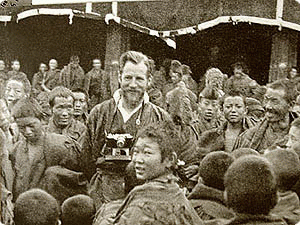 Bernard at Drepung Monastic
University, c.1937
In traveling to Tibets
“Forbidden City,” Bernard followed the route established by
his British predecessors from Sikkim, up through the Chumbi
Valley, to Gyantse, from where he petitioned for entry to
Lhasa. When approval for his visit finally came, Bernard set
out with his party. Upon entering the Lhasa valley, the
first site he came upon was Drepung Monastic University. “It
was but a short distance before we came around the bend
which sheltered the great monastery of Drepung, the largest
in the world, holding in the neighborhood of 10,000 monks.
It was a startling sight: white masonry studded over with
the black spots, which indicates the endless series of
chambers, gloomy cells of meditation. … I had seen endless
pictures of this sanctuary, yet it was wholly unlike such
preliminary impressions. The truth is, no film could
possibly convey its majesty. There is a sense of
immaculateness about it which eludes the camera, so faithful
in capturing external forms”.
Attempting to visit all the notable
locations in the Lhasa valley, Bernard also visited Ganden
monastery, requiring a journey up into the hills surrounding
Lhasa. “Dressed in a Tibetan robe, and accompanied by my
bodyguard, I headed towards the sacred monastery of Ganden,
situated on top of the mountain. . . . Here, to my mind, was
the ideal monastery, tucked away as it was in a hidden
corner in the bend of one of the higher ridges which juts
out into the valley. For could there be a more ideal place
for a monastery than among the gathering clouds of heaven
yet remain completely hidden from everyone passing up and
down the valley? I vow that any human being dwelling in a
like place would be unable to think of anything else; the
country hereabouts surely awakens all the religious awe that
any soul might possess”.
Bernard at Drepung Monastic
University, c.1937
In traveling to Tibets
“Forbidden City,” Bernard followed the route established by
his British predecessors from Sikkim, up through the Chumbi
Valley, to Gyantse, from where he petitioned for entry to
Lhasa. When approval for his visit finally came, Bernard set
out with his party. Upon entering the Lhasa valley, the
first site he came upon was Drepung Monastic University. “It
was but a short distance before we came around the bend
which sheltered the great monastery of Drepung, the largest
in the world, holding in the neighborhood of 10,000 monks.
It was a startling sight: white masonry studded over with
the black spots, which indicates the endless series of
chambers, gloomy cells of meditation. … I had seen endless
pictures of this sanctuary, yet it was wholly unlike such
preliminary impressions. The truth is, no film could
possibly convey its majesty. There is a sense of
immaculateness about it which eludes the camera, so faithful
in capturing external forms”.
Attempting to visit all the notable
locations in the Lhasa valley, Bernard also visited Ganden
monastery, requiring a journey up into the hills surrounding
Lhasa. “Dressed in a Tibetan robe, and accompanied by my
bodyguard, I headed towards the sacred monastery of Ganden,
situated on top of the mountain. . . . Here, to my mind, was
the ideal monastery, tucked away as it was in a hidden
corner in the bend of one of the higher ridges which juts
out into the valley. For could there be a more ideal place
for a monastery than among the gathering clouds of heaven
yet remain completely hidden from everyone passing up and
down the valley? I vow that any human being dwelling in a
like place would be unable to think of anything else; the
country hereabouts surely awakens all the religious awe that
any soul might possess”.
 “Each of the large wooden blocks was
carved by hand, and its printing as perfect as that done by
our machinery.”
Zhol Publishing House,
Lhasa
A priority for Bernard in his
journey to Tibet was the acquisition of a complete set of
the Tibetan Buddhist canon in 338 volumes. This he managed
to acquire along with many more volumes of the collected
works of numerous Tibetan authors provided him by the
Regent, Reting Rinpoche. These books were to serve as the
focus of Bernards efforts over the subsequent ten
years as he attempted to establish a research center for
their translation into the English language.
“Tsarong had finally decided to give
me his Kangyur and Tengyur, because he feared I would take
the chance of leaving Tibet by way of China. His attitude
was that my life was precious and that I should not take any
chances”.
“Anyone coming to my room would have
thought that I had opened up a tailor shop to see yards upon
yards of silks strewn around the room, and the tailor and
his assistant marking it off. The custom for taking care of
the precious sacred volumes is to wrap them in large pieces
of silk, after which each book must be marked and indexed
from the outside, so that one might find the desired volume
without having to unwrap each one”.
“I found the Tibetans the most
gracious people on earth, and never before had I such
friendship extended me by foreigners.”
Of the many volumes of books brought
back from Tibet by Theos Bernard, Yale University acquired
more than two hundred volumes of his Tibetan texts including
his copy of the 63-volume Treasury of Revealed Teachings for
its library in 1963. The remainder of materials brought back
from Tibet serves as the core of the Theos Bernard Tibetan
Collection at the University of California,
Berkeley.
Submitted
by Paul G. Hackett
“Each of the large wooden blocks was
carved by hand, and its printing as perfect as that done by
our machinery.”
Zhol Publishing House,
Lhasa
A priority for Bernard in his
journey to Tibet was the acquisition of a complete set of
the Tibetan Buddhist canon in 338 volumes. This he managed
to acquire along with many more volumes of the collected
works of numerous Tibetan authors provided him by the
Regent, Reting Rinpoche. These books were to serve as the
focus of Bernards efforts over the subsequent ten
years as he attempted to establish a research center for
their translation into the English language.
“Tsarong had finally decided to give
me his Kangyur and Tengyur, because he feared I would take
the chance of leaving Tibet by way of China. His attitude
was that my life was precious and that I should not take any
chances”.
“Anyone coming to my room would have
thought that I had opened up a tailor shop to see yards upon
yards of silks strewn around the room, and the tailor and
his assistant marking it off. The custom for taking care of
the precious sacred volumes is to wrap them in large pieces
of silk, after which each book must be marked and indexed
from the outside, so that one might find the desired volume
without having to unwrap each one”.
“I found the Tibetans the most
gracious people on earth, and never before had I such
friendship extended me by foreigners.”
Of the many volumes of books brought
back from Tibet by Theos Bernard, Yale University acquired
more than two hundred volumes of his Tibetan texts including
his copy of the 63-volume Treasury of Revealed Teachings for
its library in 1963. The remainder of materials brought back
from Tibet serves as the core of the Theos Bernard Tibetan
Collection at the University of California,
Berkeley.
Submitted
by Paul G. Hackett
Barbarian lands: Theos Bernard, Tibet, and the American religious life. Ph.D. Thesis, Columbia University, 2008. 1102 pp.- Hackett, Paul Gerard This dissertation presents the first comprehensive narrative of the life of Theos Bernard (1908-1947). As a first-generation American explorer in Tibet, Bernard was only the third American to successfully reach Lhasa, the capital of Tibet in the late 1930s. While there, Bernard amassed what would be the largest collection of Tibetan texts, art and artifacts in the Western hemisphere for more than thirty years, as well as documenting, in both still photography and 16mm film, an age-old civilization on the eve of its destruction. In his day, Bernard met, associated and corresponded with the social, political and cultural icons of his day, from the Regent and leading politicians of Tibet to saints, scholars and diplomats in British India, and such notables as Charles Lindbergh, Gandhi, and Franklin Delano Roosevelt. Bernard also established a research center in California to collaborate with a man considered the most important Tibetan intellectual of the twentieth century, Amdo Gedun Chopel. When they were unable to overcome the turmoil of the 1940s, however, their collaboration failed and instead, within ten years both men would be dead. The dissertation examines such issues as Bernards place in the early history of the American subculture and counter-culture informed by Indian concepts of religiosity and the narrative of the genesis and spread of Indian and Buddhist religious traditions in America over the last 150 years. In addition, Bernards life and writings are examined as a paradigm of an ethnically American counter-culture religious experience and his academic activities are discussed in terms of their broader implications for the study of religion. The dissertation concludes with a series of appendices containing presentations of some of the primary data amassed over the course of the research, including: some of Bernards unpublished works; an overview of American visitors to Tibet from 1920 to 1959; and a photographic essay retracing Bernards trips in India and Tibet with comparative photographs (1937 and 2006). Barbarian lands: Theos Bernard, Tibet, and the American religious life. Ph.D. Thesis, Columbia University, 2008. 1102 pp.- Hackett, Paul Gerard |
